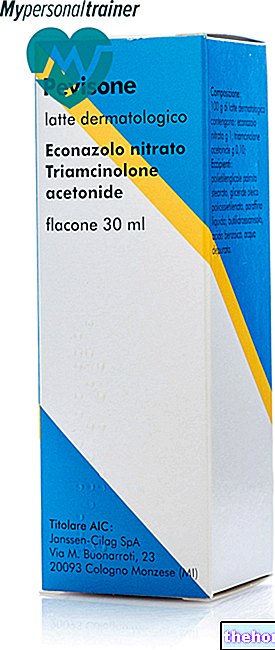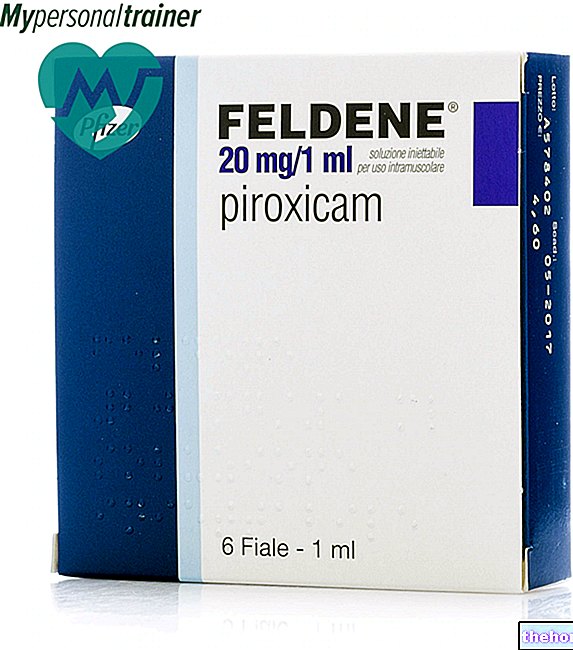Active ingredients: Piroxicam
Kinskidol Cream
Why is Kinskidol used? What is it for?
PHARMACOTHERAPEUTIC CATEGORY (OR TYPE OF ACTIVITY ")
Anti-inflammatory for local use.
THERAPEUTIC INDICATIONS
Painful and inflammatory states of a rheumatic or traumatic nature of the joints, muscles, tendons and ligaments.
Contraindications When Kinskidol should not be used
Individual ascertained hypersensitivity to the product.
Third trimester of pregnancy.
Feeding time.
Precautions for use What you need to know before taking Kinskidol
The use, especially if prolonged of the products for topical use, can give rise to sensitization phenomena, in which case it is necessary to interrupt the treatment and institute a suitable therapy.
Interactions Which drugs or foods can modify the effect of Kinskidol
Not known.
Warnings It is important to know that:
Pregnancy and breastfeeding
Inhibition of prostaglandin synthesis can adversely affect pregnancy and / or embryo / fetal development.
Results of epidemiological studies suggest an increased risk of miscarriage and cardiac malformation and gastroschisis after use of a prostaglandin synthesis inhibitor in early pregnancy. The absolute risk of cardiac malformations increased from less than 1% up to approximately 1.5%. The risk has been believed to increase with dose and duration of therapy. In animals, administration of prostaglandin synthesis inhibitors has been shown to cause increased pre- and post-implantation loss and embryo-fetal mortality. In addition, an increased incidence of various malformations, including cardiovascular, has been reported in animals given prostaglandin synthesis inhibitors during the organogenetic period.
During the third trimester of pregnancy, all prostaglandin synthesis inhibitors can expose
the fetus to:
- cardiopulmonary toxicity (with premature closure of the arterial duct and pulmonary hypertension);
- renal dysfunction, which can progress to renal failure with oligo-hydroamnios;
the mother and the newborn, at the end of pregnancy, to:
- possible prolongation of bleeding time, and antiplatelet effect which may occur even at very low doses;
- inhibition of uterine contractions resulting in delayed or prolonged labor
Dosage and method of use How to use Kinskidol: Dosage
Apply 2-3 times per day, with a light massage to facilitate absorption.
Overdose What to do if you have taken too much Kinskidol
There are no known effects to be attributed to Kinskidol overdose
Side Effects What are the side effects of Kinskidol
There are no reported undesirable effects due to the local use of piroxicam.
Report any undesirable effects not described in this leaflet to your doctor or pharmacist.
Expiry and Retention
Warning: do not use the medicine after the expiry date indicated on the package
KEEP OUT OF THE REACH AND SIGHT OF CHILDREN
Composition and pharmaceutical form
COMPOSITION
100 g of cream contain: Active Ingredient: Piroxicam g 1
Excipients: mint essence, pine essence, ethylene glycol and polyethylene glycol palmite stearate, polyoxyethylenated saturated glycerides, petroleum jelly, butylhydroxyanisole, methyl p-oxybenzoate, propyl p-oxybenzoate, water.
PHARMACEUTICAL FORM AND PACKAGING
Cream 50 g 1% for dermatological use.
Source Package Leaflet: AIFA (Italian Medicines Agency). Content published in January 2016. The information present may not be up-to-date.
To have access to the most up-to-date version, it is advisable to access the AIFA (Italian Medicines Agency) website. Disclaimer and useful information.
01.0 NAME OF THE MEDICINAL PRODUCT
KINSKIDOL CREAM
02.0 QUALITATIVE AND QUANTITATIVE COMPOSITION
100 g of cream contain:
Active principle: piroxicam 1 g
03.0 PHARMACEUTICAL FORM
50 g tube of 1% cream for dermatological use.
04.0 CLINICAL INFORMATION
04.1 Therapeutic indications
Painful and inflammatory states of a rheumatic or traumatic nature of the joints, muscles, tendons and ligaments.
04.2 Posology and method of administration
Spread an appropriate amount of cream on the painful area, massaging slowly until completely absorbed, repeating the administration 2-3 or more times a day.
04.3 Contraindications
Individual ascertained hypersensitivity to the product.
Third trimester of pregnancy.
Feeding time.
04.4 Special warnings and appropriate precautions for use
See "Pregnancy and breastfeeding" - "Interactions with other drugs and other forms of" interaction "
Keep out of reach of children.
04.5 Interactions with other medicinal products and other forms of interaction
Based on bioavailability studies, KINSKIDOL cream is extremely unlikely to displace other plasma protein-bound drugs. However, physicians will need to monitor patients treated with KINSKIDOL cream and high protein binding drugs for any dose adjustments.
04.6 Pregnancy and lactation
As with other NSAIDs, KINSKIDOL cream should not be administered in known or presumed pregnancy and during lactation. KINSKIDOL cream inhibits the synthesis and release of prostaglandins through an effect on prostaglandinbiosynthetase. This effect, as with other NSAIDs, has been associated. with increased frequency of dystocia events and protracted parturition in pregnant animals in which the administration of the drug was carried out in the last gestation period.
Pregnancy
Inhibition of prostaglandin synthesis can adversely affect pregnancy and / or embryo / fetal development.
Results of epidemiological studies suggest an increased risk of miscarriage and cardiac malformation and gastroschisis after use of a prostaglandin synthesis inhibitor in early pregnancy. The absolute risk of cardiac malformations increased from less than 1% to approximately 1.5%. The risk has been considered to increase with dose and duration of therapy.
In animals, administration of prostaglandin synthesis inhibitors has been shown to cause increased pre- and post-implantation loss and embryo-fetal mortality.
In addition, an increased incidence of various malformations, including cardiovascular, has been reported in animals given prostaglandin synthesis inhibitors during the organogenetic period.
During the third trimester of pregnancy, all prostaglandin synthesis inhibitors can expose
the fetus to:
• cardiopulmonary toxicity (with premature closure of the arterial duct and pulmonary hypertension);
• renal dysfunction, which can progress to renal failure with oligo-hydroamnios;
the mother and the newborn, at the end of pregnancy, to:
• possible prolongation of bleeding time, and antiplatelet effect which may occur even at very low doses;
• inhibition of uterine contractions resulting in delayed or prolonged labor
04.7 Effects on ability to drive and use machines
There has been no reported effect of KINSKIDOL cream on the ability to drive and use machines.
04.8 Undesirable effects
Topical piroxicam is well tolerated and no undesirable reactions attributable to it are observed. The application of products for topical use, especially if prolonged, can give rise to sensitization phenomena. In the presence of hypersensitivity reactions, the treatment must be interrupted and appropriate therapy instituted.
04.9 Overdose
No cases of overdosing have been reported in the literature so far.
05.0 PHARMACOLOGICAL PROPERTIES
05.1 Pharmacodynamic properties
Piroxicam is an NSAID with a marked anti-inflammatory and analgesic activity which is also associated with an antipyretic effect. The mechanism of action is mainly constituted by an inhibition of the biosynthesis of prostaglandins, known mediators of the inflammatory process, while any interference of the drug on the pituitary-adrenal system is excluded. The activity of the active principle administered percutaneously in the various models of acute and chronic inflammation appears to be very relevant, even in the presence of reduced plasma levels. This finds a convincing explanation in the marked tropism of piroxicam, conveyed percutaneously, for the inflamed site. .
05.2 "Pharmacokinetic properties
Studies conducted in both humans and animals have shown that the "systemic" bioavailability of epicutaneous application is about 1/40 of that by mouth (comparison of kinetics with equiponderal doses).
05.3 Preclinical safety data
Toxicological tests carried out on various animal species have shown that KINSKIDOL cream is well tolerated and lacks photosensitizing, teratogenic and mutagenic activity. In mice, rats and dogs, the LD50 per os after a single administration is respectively 360, 270 and over 700 mg / kg, while, by the peritoneal route in mice and rats, it is 360 and 220 mg / kg / day, respectively. This latter dose is approximately 60 times greater than that indicated for humans.
The only pathological events observed, at the maximum dose used, consisted of renal papillary necrosis and gastrointestinal lesions.
06.0 PHARMACEUTICAL INFORMATION
06.1 Excipients
100 g of cream contain:
• mint essence (0.005 g)
• essence of pine (0.01 g)
• ethylene glycol and polyethylene glycol palmite stearate (20 g)
• polyoxyethylene saturated glycerides (3 g)
• vaseline oil (3 g)
• butylhydroxyanisole (0.05 g)
• methyl p-oxybenzoate (0.1 g)
• propyl p-oxybenzoate (0.05 g)
• water to taste at 100 g (72.785 g)
06.2 Incompatibility
See "Interactions".
06.3 Period of validity
36 months in intact packaging.
06.4 Special precautions for storage
There are no special storage precautions for KINSKIDOL cream.
06.5 Nature of the immediate packaging and contents of the package
1% cream tube of 50 g.
06.6 Instructions for use and handling
---
07.0 MARKETING AUTHORIZATION HOLDER
Farmaceutici Caber S.p.A. - Viale Città d "Europa, 681 - Rome
08.0 MARKETING AUTHORIZATION NUMBER
AIC n. 025496062
09.0 DATE OF FIRST AUTHORIZATION OR RENEWAL OF THE AUTHORIZATION
19.11.1987 / 31.05.2005 / 31.05.2010
10.0 DATE OF REVISION OF THE TEXT
May 2010























-nelle-carni-di-maiale.jpg)




